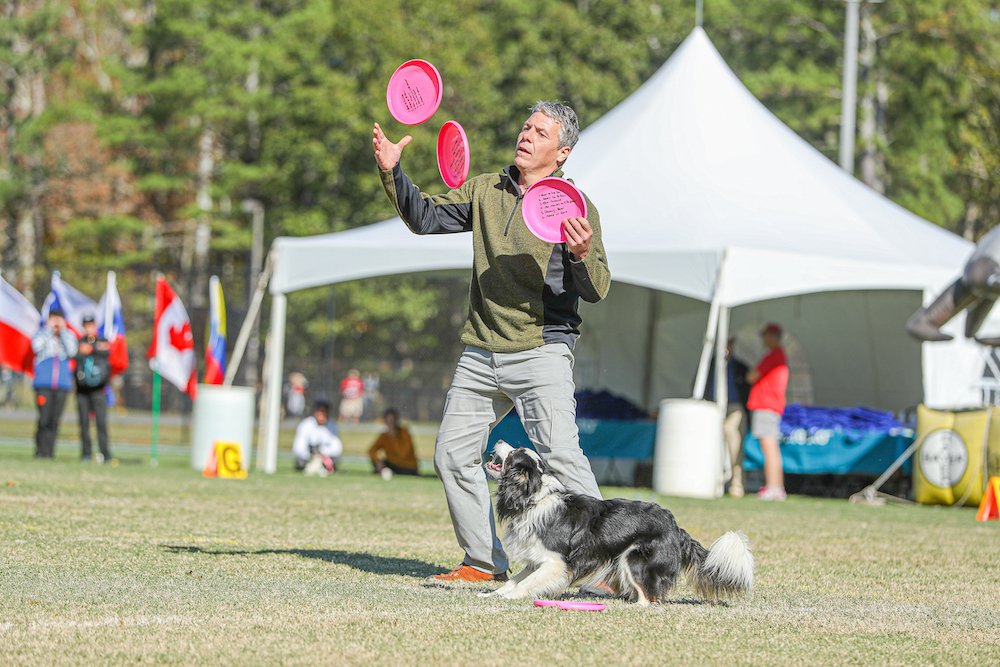
Disc Dog Opinion: What Is a Multiple?
Definition
A multiple is a segment with a minimum of three consecutive throws in rapid succession. (USDDN Rules 2019, p. 15)
Most multiples happen on interior sequences near or on the handler, but it can happen with longer throws to a moving dog at a distance. The interior multiple on and around the handler usually happens in one of two fashions which we have names for: a Juggle or a Shuffle.
Juggle
The Juggle is based off of the Give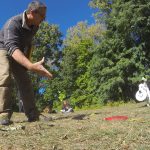 The Give is a retrieve to the hand. A cued Give is a foundational skill that is not super useful in the actual performance of disc dog freestyle, and has huge applications for... More skill, and can be thought of as multiple Gives in rapid succession. The definition of multiple Gives is very useful for training and theory purposes as it requires the disc be caught and controlled by the dog and then released into the handler’s hand. This catch and give movement results in something that looks like a team juggling the discs between them.
The Give is a retrieve to the hand. A cued Give is a foundational skill that is not super useful in the actual performance of disc dog freestyle, and has huge applications for... More skill, and can be thought of as multiple Gives in rapid succession. The definition of multiple Gives is very useful for training and theory purposes as it requires the disc be caught and controlled by the dog and then released into the handler’s hand. This catch and give movement results in something that looks like a team juggling the discs between them.
Shuffle
The Shuffle is based off the Drop skill, and can be thought of as multiple Drops in rapid succession. The definition of multiple Drops is useful for training and theory purposes as a Drop requires the dog to first be holding the disc which means that the dog actually has to catch the disc – you can’t drop it if you’re not holding it, and you can’t hold it unless you have first caught it.
Distance Multiples and Longer Throws
When executing multiples at a distance, in order to keep to the criteria of consecutive throws in rapid succession two, or even three discs can and should be in the air at the same time.
The distance multiple is an exciting large scale trick that puts drive for catching discs and disc management by the dog on clear display and challenges the handler’s throwing ability and disc placement.
Variations
Each of the types of multiple have an endless number of variations that can be broken down into three basic concepts:
- Type of throw
- PositionIn the Play+ philosophy, "Position" is the final stage within the "Next" phase of a Cycle of Play. It acts as a pivotal link between the "Next" phase and a new "Now" phase. More
- Movement
Playing around with these three concepts can and does lead to creative expressions of the Multiple. These expressions can and should create challenging applications for dog and handler and may change the entire look and nature of the Multiple from a judges and fan’s perspective.
For instance, the dog can be standing on hind legs. The handler can throw upside down. The dog can be in a stall, on the handler’s body. The dog can be performing flips, leaps, or running across the field.
The key element that defines the Multiple is right there in the definition: rapid fire succession. Anything goes, but if it’s not rapid fire, it’s not a Multiple.
Old School Multiples – Fast and Focused
Back in the day, the in the 1990s and the ’00s, the essence of the multiple, namely the rapid fire nature, was highlighted and delivered the bulk of the scoring. While the positions and the movements were not super unique or creative, the speed and intensity of the rapid fire nature was on display and was the main criteria for scoring this unique skill. And the speed and intensity of the multiples back in the day were quite intense. Melissa Heeter had a smoking fast Shuffle.
This focus on the speed and rapid fire nature of the Multiple placed great challenge on both the dog and handler to throw and catch both cleanly and well. Many multiples were thrown where the dog never clamped down and controlled the catch and many Juggles were performed where the handler was essentially juggling with him or herself, making the catches for the dog if the speed was too great or the dog was not well heeled in the skill. These faults were noted on the judges scorecard and pitted against the speed and intensity and creative position, movement, and throw.
The Challenge
The challenge was to be as fast as possible while still maintaining the clean and controlled catch. This challenge is not without it’s competitive merits and training applications.
On a really fast multiple, the handler is challenged to deliver a highly precise throw while loading and preparing the next disc. Melissa’s Shuffle was blindingly fast in this regard, and it highlighted her terrific throwing and disc handling skills. These throwing and disc handling skills are what are being tested on a Multiple, be it Juggle, Shuffle, or Distance Multiple.
The dog is challenged to both clearly catch the disc, securing it within the jaws, and cleanly Drop or Give that disc back to the handler while tracking or eyeballing the next disc coming in. Often the dog has two discs inside the jaws at the same time and must somehow make the catch with a bunch of disc traffic in and around his or her mouth.
The Benefits
There are many benefits to working and developing a strong, fast, and focused Multiple.
The dog’s position can be isolated and reinforced through Multiple training, teaching the dog that they don’t need to fire and fly forward on the catching of a disc. Creating a stable position and isolating the concept of simply catching a disc is a very important skill that many modern disc dogs simply don’t have.
Heavy repetition and reinforcement of the cued Drop or Give is also a huge benefit of this skill. The CPM CPM means cookies per minute. It is a fun expression for rate of reinforcement, a very important dog training concept. CPM should be between 15 to 30 CPM when learning or adding value... More (cookies per minute) that can be generated on either the Drop or the Give with a multiple is really hard to beat. A quick pick up in between can lead to a massive rate of reinforcement for either skill.
CPM means cookies per minute. It is a fun expression for rate of reinforcement, a very important dog training concept. CPM should be between 15 to 30 CPM when learning or adding value... More (cookies per minute) that can be generated on either the Drop or the Give with a multiple is really hard to beat. A quick pick up in between can lead to a massive rate of reinforcement for either skill.
Gaining confidence and competence in disc handling is also a tremendous benefit from this skill. Being fast and focused with handling discs is an acquired skill that requires focus and practice. Training a Multiple is a great way to get focused and practiced at agile disc handling.
New School Multiples – Creative, Complex, but Clunky
Now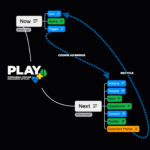 The Now Phase is an integral part of the Play Cycle in the Play+ training philosophy. It embodies the current, immediate interaction between the handler and the dog, anchoring them in the present... More I’m gonna bag on new school multiples a bit and indulge an old crusty discdogger who’s been around the block a few times…
The Now Phase is an integral part of the Play Cycle in the Play+ training philosophy. It embodies the current, immediate interaction between the handler and the dog, anchoring them in the present... More I’m gonna bag on new school multiples a bit and indulge an old crusty discdogger who’s been around the block a few times…

First off, Multiples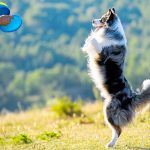 Rapid fire catches in succession, multiple sequences demonstrate dog and handler’s ability to speedily execute the throw and catch concept. Many times these sequences feature the dog in front of the handler catching... More today have tremendous potential. The creativity in terms of position and movement are just off the charts. That stuff totally wasn’t on our radar back in the day. Many of the modern multiples being showcased today were Holy Grail type fantasy ideas from back in the day. As such they are totally cool.
Rapid fire catches in succession, multiple sequences demonstrate dog and handler’s ability to speedily execute the throw and catch concept. Many times these sequences feature the dog in front of the handler catching... More today have tremendous potential. The creativity in terms of position and movement are just off the charts. That stuff totally wasn’t on our radar back in the day. Many of the modern multiples being showcased today were Holy Grail type fantasy ideas from back in the day. As such they are totally cool.
The problem is that many of the new school Multiples are not really multiples at all as they are lacking the “rapid succession” part of the definition. And that is a critical omission.
The reason I’m writing this piece is threefold: to clearly lay out the definition of a multiple, to help people realize that foundation of the multiple (rapid fire catches) first is key to having a strong competitive multiple, and to raise the bar and clear up a judging issue with the modern expression of the Multiple.
If your 3 throw multiple takes a couple seconds to execute, it’s not really a multiple. Add a couple of seconds for getting prepped, and the high paced, rapid-fire Multiple can be something of a downer in a routine.
Get Function THEN Fancy
Form over function is a common problem in modern society, and it’s a real problem with the disc dog Multiple.
So many people are caught up in having a “unique” multiple, putting form above function, that they wind up creating something that is not much of a Multiple at all.
When starting out with the Multiple, be it a Juggle, Shuffle, or Distance Multiple, get the function first, then get fancy. Train the concept of the multiple first; that rapid fire throw and catch is key. It has great value in both training and performance.
Once you’ve gotten the function of the Multiple down, you can throw and load quickly, your dog can catch and Drop/Give quickly, then go and add the form to the function. Get creative after you get the foundation, and your creative expression of the Multiple, regardless of position, movement, or throw, will be much faster and functional.
And don’t be afraid to put together a super-fast but simple multiple for performance purposes. If it really is super fast, that speed should deliver some solid scores from experienced judges.







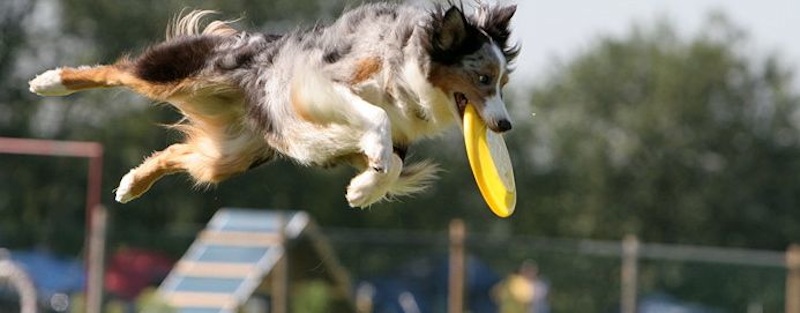
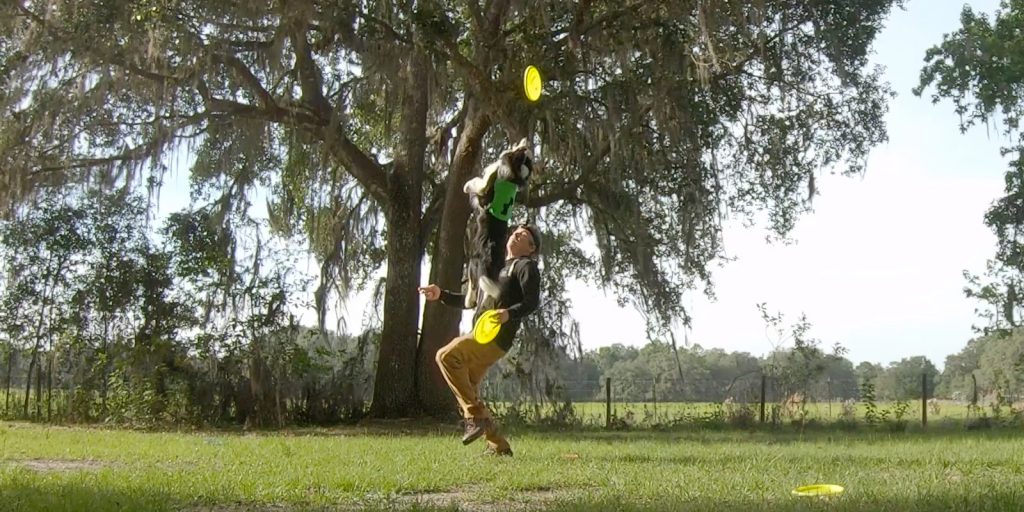
Thanks for this interesting article, Ron. I haven’t recognized strong potential of Multiples, because old school Multiples don’t looking so “cool” and “fancy”. But now I think we should pay attention on that.
I had the same problem. Just some solid focus on it with a couple dogs who have issues and I see it’s value all over the place. Had some nice work with King last night on the skill.
Crazy stuff…